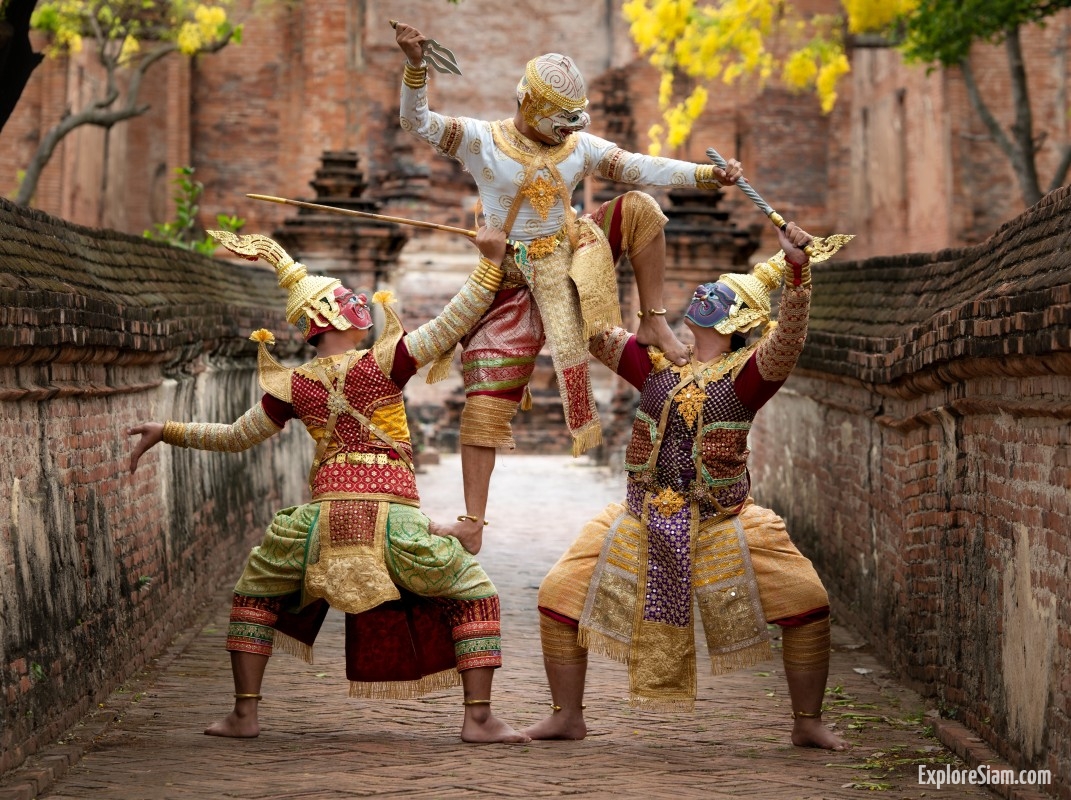Khon, the traditional Thai mask dance, is a deeply rooted cultural art form that combines intricate dance movements, elaborate costumes, and dramatic storytelling. Originating from Thailand’s rich history, Khon has evolved over centuries to become one of the country’s most revered and symbolic performances. This article delves into the history, significance, elements, and modern-day adaptations of Khon, offering a comprehensive overview of this mesmerizing art.
History of Khon
Khon traces its origins back to the Ayutthaya period (1350-1767), where it was primarily performed in the royal court. Initially, Khon was an exclusive art form reserved for royalty and the aristocracy, serving as a means to depict tales from the Ramakien, the Thai version of the Indian epic Ramayana. The dance’s intricate movements and elaborate costumes were designed to convey the grandeur and sophistication of the Thai monarchy.
The influence of Hinduism and Buddhism in Thailand played a significant role in shaping Khon. The Ramakien, which tells the story of Prince Rama’s quest to rescue his wife Sita from the demon king Ravana, became the central narrative for Khon performances. Over time, Khon incorporated elements from various other Thai art forms, such as classical dance, puppet theater, and traditional music.
Significance of Khon
Khon is more than just a dance; it is a cultural expression that embodies Thailand’s historical, religious, and artistic heritage. Each performance is a blend of mythology, drama, and dance, reflecting the values and beliefs of Thai society. The use of masks and costumes in Khon is particularly symbolic, representing different characters and their roles within the story. For instance, green masks often signify the hero, Rama, while red masks represent the demon king, Ravana.
In addition to its cultural significance, Khon serves as an educational tool. Through its performances, Khon imparts moral lessons and virtues such as loyalty, bravery, and righteousness. The stories from the Ramakien are not just entertainment but also a means to teach and reinforce ethical principles within Thai society.
Elements of Khon
Dance Movements
Khon is characterized by its precise and highly stylized movements. Performers undergo rigorous training to master the dance’s intricate gestures, which are essential for conveying the story and emotions of the characters. The movements are often accompanied by dramatic facial expressions and postures, creating a visually striking performance.
Costumes and Masks
The costumes and masks used in Khon are elaborate and meticulously crafted. Each character has a distinct costume that reflects their personality and role in the story. The masks, often made from papier-mâché or metal, are intricately painted and adorned with jewels and other decorations. The costumes are equally elaborate, featuring vibrant colors, gold accents, and detailed embroidery.
Music and Narration
Music plays a crucial role in Khon performances, providing the rhythmic foundation for the dance movements. Traditional Thai instruments such as the piphat (a type of ensemble) and the ranat (a xylophone-like instrument) are commonly used. The music is often accompanied by narrators who describe the story and dialogue, as the performers typically do not speak.
Storytelling
The core of Khon lies in its storytelling. The performances are based on episodes from the Ramakien, with each scene meticulously choreographed to convey the narrative. The combination of dance, music, and narration creates a powerful and immersive storytelling experience.
Modern Adaptations and Preservation
While Khon remains deeply rooted in tradition, it has also adapted to contemporary times. Modern Khon performances can be seen in various settings, from traditional theaters to cultural festivals and even international stages. Efforts to preserve and promote Khon include incorporating it into school curriculums, establishing dedicated Khon training centers, and organizing workshops and performances for younger generations.
The Thai government and cultural organizations have also played a significant role in preserving Khon. In 2018, UNESCO recognized Khon as an Intangible Cultural Heritage of Humanity, highlighting its cultural importance and the need for its preservation. This recognition has further boosted efforts to promote Khon both domestically and internationally.
Khon, the traditional Thai mask dance, is a captivating art form that embodies Thailand’s rich cultural heritage. Through its intricate dance movements, elaborate costumes, and dramatic storytelling, Khon offers a unique and immersive experience that transcends time. As Thailand continues to evolve, the preservation and promotion of Khon ensure that this cultural treasure remains a vital part of the nation’s identity. Whether experienced in a traditional setting or a modern adaptation, Khon continues to enchant and inspire audiences, celebrating the enduring legacy of Thai artistry and tradition.





